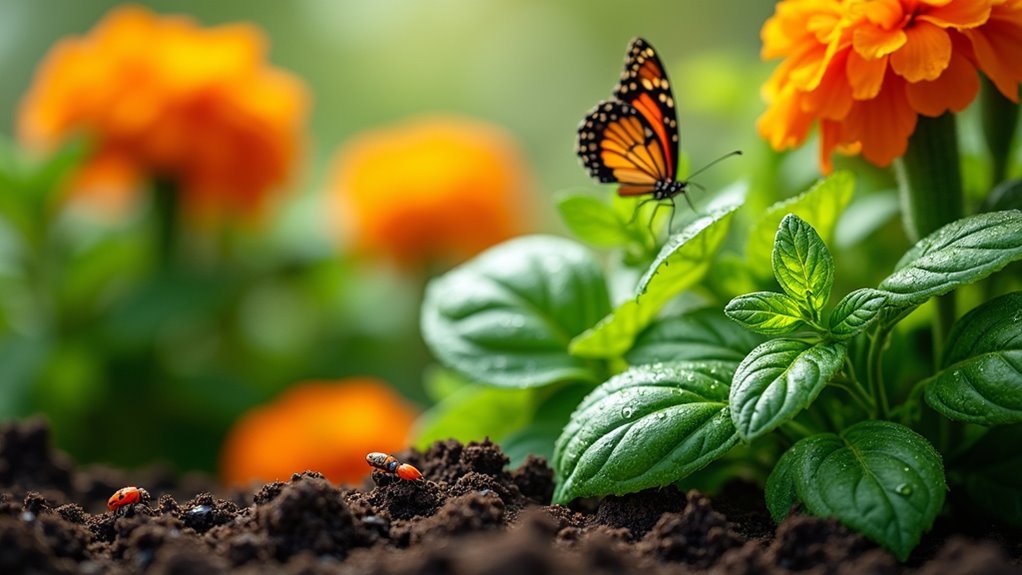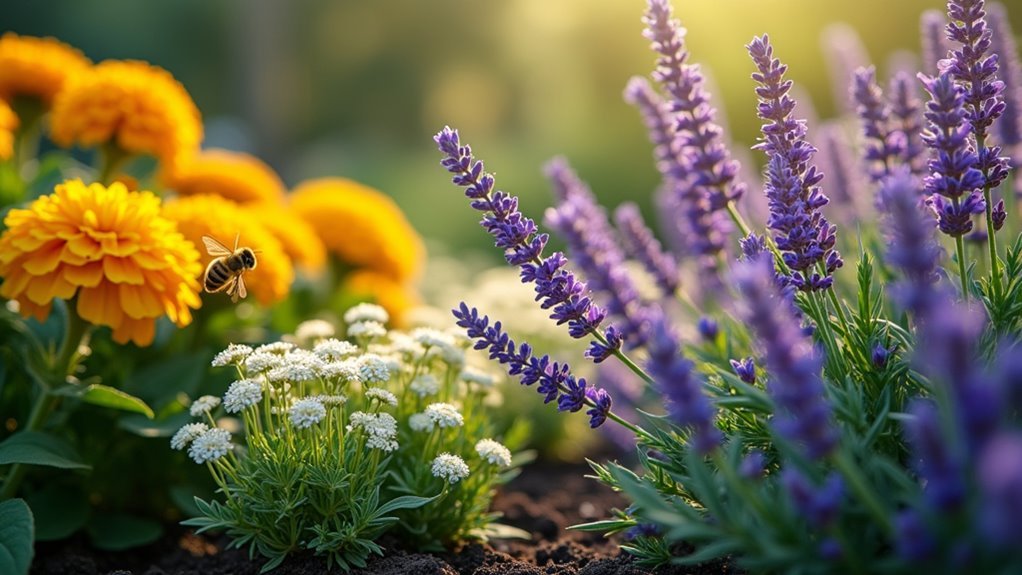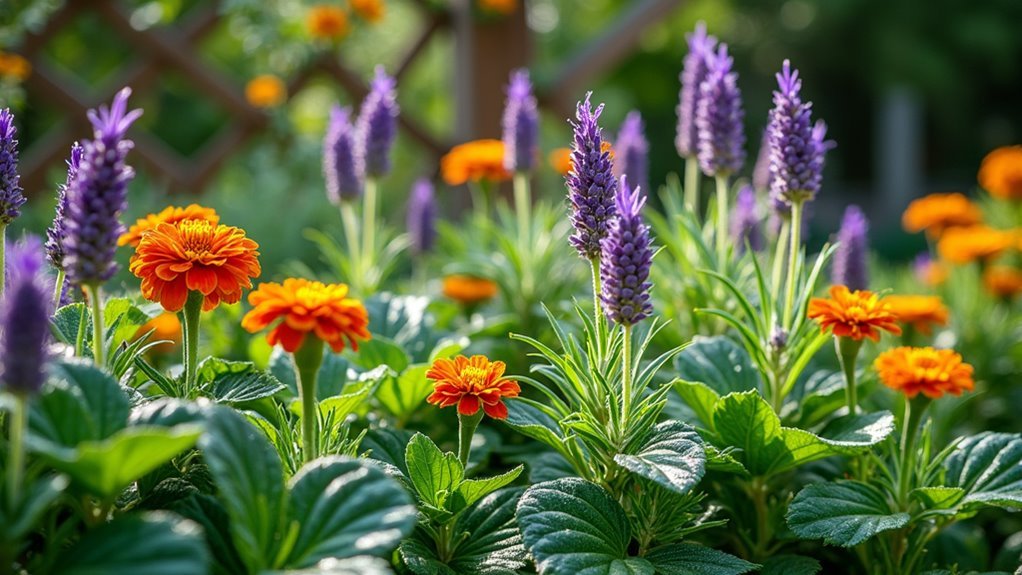You can protect your garden naturally by planting aromatic herbs like basil, lavender, and rosemary that repel mosquitoes and various pests through their essential oils. Colorful marigolds and chrysanthemums deter aphids, nematodes, and Japanese beetles while adding vibrant beauty to your landscape. Garlic, onions, and chives from the allium family release sulfur compounds that keep harmful insects away from nearby vegetables. Strategic companion planting and trap crops create powerful defense systems that’ll transform your garden ecosystem.
How Plants Naturally Repel Garden Pests

While chemical pesticides may seem like the obvious solution to garden pest problems, many plants have evolved their own sophisticated defense mechanisms that you can harness for natural pest control.
These remarkable plants repel unwanted insects through various methods, primarily by releasing potent essential oils and chemical compounds that create an unwelcoming environment for pests.
Aromatic flowers and herbs like basil, lavender, and chrysanthemums emit powerful scents that naturally deter mosquitoes, flies, and other harmful insects.
Meanwhile, plants containing specific compounds—such as garlic’s sulfur or chrysanthemum’s pyrethrum—actively repel targeted pests.
Through strategic companion planting, you’ll create a protective barrier around your garden while simultaneously attracting beneficial insects that help maintain ecological balance and further control pest populations naturally.
Essential Aromatic Herbs for Pest Control
Five powerful aromatic herbs can transform your garden into a natural pest-control fortress while adding culinary value to your landscape.
These aromatic herbs offer effective natural pest control through their essential oils and strong scents.
Basil repels mosquitoes, flies, and tomato hornworms while thriving in zones 4-11.
Plant it near seating areas for maximum protection.
Lavender attracts beneficial pollinators yet deters moths and fleas with its calming fragrance in zones 5-9.
Rosemary releases oils that repel insects like mosquitoes and cabbage moths, preferring full sun in zones 7-10.
Mint contains potent oils that repel ants and fleas—grow it in containers to control spread.
Lemon Thyme effectively deters mosquitoes and cockroaches, especially when leaves are crushed.
Colorful Flowers That Deter Harmful Insects

You’ll find that colorful flowers can serve double duty in your garden by providing vibrant beauty while actively repelling harmful insects.
Marigolds are particularly effective against garden pests, as their strong scent drives away mosquitoes, aphids, and nematodes when planted alongside your vegetables.
Chrysanthemums offer another powerful option for natural insect control, containing pyrethrum that deters roaches, ticks, and Japanese beetles while still attracting beneficial insects to your garden.
Marigolds Against Garden Pests
Among the most effective natural pest deterrents in any garden, marigolds stand out as vibrant warriors against harmful insects.
You’ll find these colorful flowers can repel pests like aphids, nematodes, and mosquitoes through their strong scent and pyrethrum content, a natural insect repellent. Their pest-repelling properties make them excellent garden protection allies that keep insects away while attracting beneficial insects like pollinators.
You can plant marigolds as trap crops near vulnerable vegetables such as tomatoes and peppers, drawing pests away from your prized plants.
They’ll thrive in zones 2-11 with full sun exposure, adapting to various garden environments.
Chrysanthemums Natural Insect Control
Chrysanthemums pack the same powerful pyrethrum compound found in marigolds, but these stunning blooms take natural pest control to the next level with their ability to repel an even broader spectrum of garden invaders.
This natural insect repellent effectively deters ants, cockroaches, ticks, fleas, and Japanese beetles while adding vibrant colors to your garden beds.
These versatile flowers offer multiple benefits for sustainable gardening:
- Dual-purpose protection – Repel harmful pests while attracting beneficial insects
- Adaptable growth – Thrive in USDA zones 5-9, reaching 1-3 feet tall
- Low maintenance – Require only full sun and well-draining soil
- Chemical-free solution – Reduce dependence on harmful chemical insecticides
You’ll create a healthier garden environment that naturally balances pest populations without compromising plant health.
Vegetable Plants With Built-In Pest Protection
You’ll find some of your favorite culinary vegetables pack a powerful punch against garden pests through their natural defense mechanisms.
Garlic’s sulfur compounds create an effective barrier that repels aphids, cabbage loopers, and Japanese beetles while adding flavor to your kitchen.
Onions and chives work similarly, with onions protecting nearby carrots and lettuce from carrot flies, while chives specifically target Japanese beetles that threaten your crops.
Garlic’s Sulfur Defense System
Garlic’s pungent aroma signals a powerful natural defense system at work in your garden. This allium family member releases sulfur compounds that effectively repel pests ranging from aphids to Japanese beetles.
You’ll find garlic’s pest-repelling properties extend beyond insects—it deters deer and rabbits too, making it an exceptional insect repellent.
Growing garlic creates a healthy garden ecosystem while providing these benefits:
- Natural pesticide alternative – eliminates need for harmful chemicals
- Versatile companion plants – enhances neighboring crops’ pest resistance
- Multi-pest protection – targets both small insects and larger animals
- Culinary bonus – harvests provide kitchen ingredients
You can cultivate this eco-friendly defender in USDA zones 3-9, requiring full sun and well-draining soil.
Plant garlic strategically among vegetables to repel pests naturally.
Onion Pest Deterrent Properties
Onions deliver powerful pest protection through their potent sulfur compounds, creating an invisible shield that drives away aphids, cabbage loopers, and Japanese beetles from your garden beds.
These natural pest deterrents work exceptionally well when you interplant them with carrots and lettuce, reducing damage from carrot flies and harmful insects.
You’ll maximize their effectiveness by growing onions in full sun with well-draining, nutrient-rich soil across USDA zones 3-9.
Beyond their direct repelling action, onions attract beneficial insects that hunt down remaining pests, creating a balanced ecosystem in your vegetable gardens.
Regular onion cultivation eliminates your need for chemical pesticides, making organic pest control both practical and sustainable while keeping your crops healthier throughout the growing season.
Chive Protection Against Beetles
Like onions, chives harness the power of sulfur compounds to create an effective barrier against destructive beetles and other garden pests.
These versatile herbs excel at companion planting, where their strong fragrance confuses and repels Japanese beetles while masking nearby vegetables from detection.
You’ll find chives particularly effective at protecting carrots from carrot flies, as their scent disrupts pest navigation.
To maximize chive protection in your garden:
- Plant in well-draining soil with full sun exposure for peak growth
- Position strategically around vulnerable vegetable crops as living barriers
- Harvest regularly to promote bushier growth and increased pest-repelling compounds
- Utilize in USDA zones 3-9 for year-round protection capabilities
This dual-purpose approach lets you repel pests naturally while growing culinary herbs for your kitchen.
Strategic Companion Planting Combinations
How can you maximize your garden’s natural defenses while minimizing pest damage?
Strategic companion planting transforms your garden into a pest-fighting powerhouse by pairing plants that work together for enhanced protection.
You’ll enhance pest control by combining marigolds with tomatoes and peppers, as these flowers repel unwanted pests while attracting beneficial insects.
Nasturtiums function as effective trap crops, protecting your valuable vegetables like cucumbers and squash by drawing aphids away from main crops.
Plant chives near carrots to keep insects away—their scent masks carrot aroma, deterring carrot flies.
Strategically placed basil around tomatoes repels mosquitoes and hornworms.
Add zinnias and sweet alyssum throughout your garden to attract predatory insects that eliminate common pests naturally.
Scented Perennials for Long-Term Pest Management

You’ll find that lavender stands out as one of the most versatile scented perennials, effectively repelling mosquitoes, cabbage moths, and numerous other garden pests with its potent aromatic oils.
The mint family offers equally impressive results, with plants like catnip proving even more effective than traditional chemical repellents against mosquitoes while simultaneously deterring ants from your garden beds.
These fragrant powerhouses provide year-round protection once established, making them smart investments for gardeners seeking sustainable pest management solutions.
Lavender’s Multi-Pest Defense
Among pest-repelling perennials, lavender stands out as a powerhouse that tackles multiple garden invaders while providing years of reliable protection.
This herbaceous perennial’s strong scent effectively repels mosquitoes, flies, fleas, and moths while simultaneously emitting a calming fragrance that humans love.
What makes lavender exceptional for pest management is its dual nature – it deters harmful insects while creating an inviting environment to attract beneficial insects like bees and butterflies.
Your garden benefits from lavender’s versatility in these ways:
- Natural deterrent – Repels four major pest types through aromatic compounds
- Pollinator magnet – Attracts bees and butterflies for enhanced biodiversity
- Multi-use applications – Creates dried bouquets and essential oils for home protection
- Low maintenance – Thrives in USDA zones 5-9 with minimal care requirements
Mint Family Effectiveness
When you’re seeking perennials that deliver exceptional pest control with scientific backing, the mint family emerges as your most reliable ally in the garden.
These pest repellent plants contain potent aromatic oils that effectively repel unwanted visitors like mosquitoes, ants, and cabbage moths.
Catnip stands out as a powerful natural alternative to chemical repellents, proving more effective than DEET in laboratory studies against mosquitoes.
Lemon thyme offers impressive results too, providing 62% of DEET’s repellency while releasing a pleasant lemony fragrance when crushed.
Standard mint varieties complete this trio, though you’ll need containment strategies since they spread aggressively.
Plant them in pots or designated areas where their vigorous growth won’t overtake neighboring plants.
All mint family members thrive in full sun and well-draining soil.
Annual Plants for Seasonal Pest Defense
Several annual plants offer powerful seasonal pest defense strategies that can transform your garden’s protection system throughout the growing season.
These seasonal annuals create pest-repelling barriers while maintaining garden aesthetics and maximizing space efficiency.
Marigolds excel as trap crops, emitting strong scents that repel aphids and nematodes while protecting vegetables like tomatoes and peppers.
Nasturtiums provide dual-purpose pest management by deterring whiteflies and squash bugs while attracting beneficial insects.
Zinnias enhance your garden’s ecosystem by drawing predatory insects that eliminate harmful pests.
Here’s how annual plants optimize your garden protection:
- Trap crops lure pests away from valuable plants
- Dual-action defense repels harmful insects while attracting beneficial ones
- Seasonal flexibility allows rotation based on specific pest pressures
- Space efficiency combines beauty with functional pest control
Trap Crops That Lure Pests Away From Vegetables
While your vegetables face constant threats from hungry insects, trap crops act as strategic decoys that intercept pests before they reach your prized produce. These plants work as natural insecticide alternatives, drawing harmful bugs away from your main crops.
| Trap Crop | Target Pests | Protected Vegetables |
|---|---|---|
| Nasturtiums | Aphids, squash bugs | Cucumbers, tomatoes |
| Marigolds | Nematodes, aphids | Most garden vegetables |
| Calendula | Various flying insects | Leafy greens, herbs |
| Radishes | Flea beetles, root maggots | Brassicas, root crops |
| Sunflowers | Stink bugs, aphids | Beans, corn |
You’ll find that marigolds excel at pest control through their strong scent, which can repel bugs while simultaneously protecting nearby cucumbers. These strategic plantings also attract beneficial insects, creating a balanced ecosystem that enhances your garden’s natural defenses without chemical intervention.
Ground Cover Plants That Create Pest Barriers
Ground cover plants transform your garden into a living fortress against unwanted pests, creating protective barriers that work around the clock.
These low-growing defenders repel insects through aromatic oils while simultaneously protecting valuable plants from damage.
Strategic ground cover selection helps you create a natural barrier that’s both functional and beautiful:
- Mint – releases strong oils that keep pests away including ants and mosquitoes
- Marigolds – emit scents deterring aphids and nematodes from surrounding areas
- Creeping thyme – suppresses weeds while repelling mosquito species effectively
- Eucalyptus varieties – produce powerful scents that drive away flies and mosquitoes
Unlike trap crops that lure pests to specific locations, these ground cover plants actively protect your garden by creating an inhospitable environment for harmful insects throughout your growing space.
Proper Placement and Spacing for Maximum Effectiveness
Choosing the right pest-repelling plants won’t deliver results if you place them incorrectly throughout your garden space. Create natural barriers by positioning these plants around your garden beds’ perimeter, blocking invasive insects before they reach vulnerable crops.
Use the 3-layer method for best sunlight distribution: tall plants like sunflowers at back, mid-level herbs in middle, and low-growing varieties at front. Proper spacing prevents overcrowding—marigolds need 6-12 inches between plants to maintain effectiveness.
Strategic interplant companion plants throughout vegetable rows for enhanced pest control while maximizing space utilization.
| Plant Type | Spacing Distance | Placement Strategy |
|---|---|---|
| Marigolds | 6-12 inches | Perimeter/between rows |
| Basil | 8-10 inches | Near tomatoes/herbs |
| Nasturtiums | 10-12 inches | Front border/ground cover |
| Sunflowers | 12-18 inches | Back row barrier |
| Thyme | 6-8 inches | Front edge/pathways |
Maintaining Your Pest-Repelling Plant Defense System
Once you’ve established your pest-repelling garden layout, consistent maintenance becomes vital for sustaining an effective defense system against unwanted insects.
Your pest-repelling plants require ongoing care to remain effective at repelling pests and maintaining robust plant health.
Monitor your plants regularly for stress or disease, as healthy plants provide superior pest deterrence.
Follow these key maintenance practices:
- Prune and deadhead flowering varieties like marigolds and chrysanthemums to promote vigorous growth.
- Fertilize with organic compost to maintain nutrient-rich soil and strengthen natural defenses.
- Rotate locations annually to prevent soil depletion and disrupt pest life cycles.
- Water appropriately to avoid weakening plants through over or underwatering.
These practices guarantee your defense system remains resilient and productive throughout the growing season.
Frequently Asked Questions
What Plant Keeps Bugs Away From the Garden?
You’ll find lavender works exceptionally well since it repels mosquitoes and flies while attracting beneficial pollinators. You can also plant basil near doorways, marigolds around vegetables, chrysanthemums for broad protection, and garlic throughout your garden.
What Is the Best Deterrent for Garden Pests?
You’ll find companion planting with multiple pest-repelling plants works best. Combine lavender, marigolds, basil, and chrysanthemums throughout your garden. This creates layered protection against various insects while maintaining natural, chemical-free pest control.
What Plant Do Insects Hate the Most?
You’ll find chrysanthemums are insects’ biggest enemy since they contain pyrethrum, a natural insecticide that repels ants, roaches, ticks, and countless other pests more effectively than most plants.
What to Plant Next to Veggies to Keep Bugs Away?
Plant basil near tomatoes to repel hornworms, marigolds around peppers for aphid control, nasturtiums beside cucumbers against whiteflies, chives with carrots to deter flies, and lavender throughout for mosquito protection.
In Summary
You’ve now got the knowledge to transform your garden into a natural fortress against pests. Start by selecting the right combination of aromatic herbs, colorful deterrent flowers, and strategic trap crops for your space. Remember, you’ll need to maintain proper spacing and regularly care for these plants to keep their pest-repelling properties strong. With patience and consistent effort, you’ll create an effective, chemical-free defense system that’ll protect your vegetables while supporting beneficial insects.





Leave a Reply